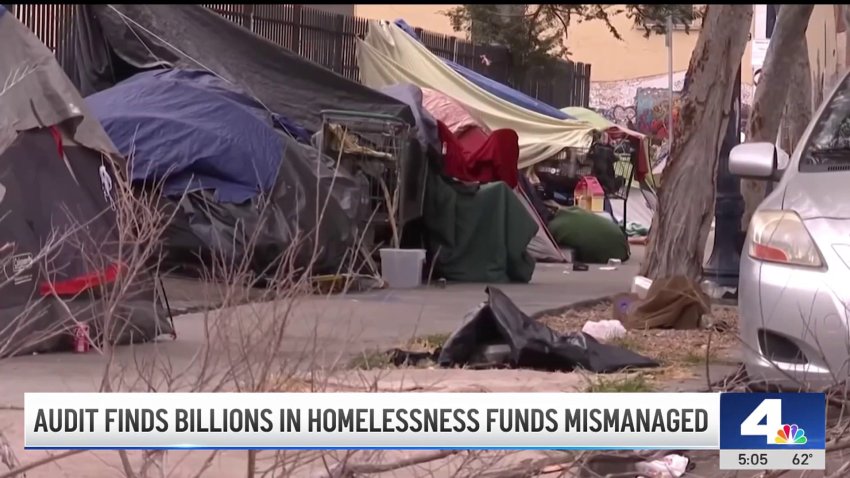The sales tax for a couple of cities in the Antelope Valley will go beyond 11% starting Tuesday. Conan Nolan reports for the NBC4 News at 6 p.m. on Monday, March 31, 2025.
A sales tax approved by voters in November to fund programs that combat the homeless crisis in Los Angeles County went into effect Tuesday.
The increase means people in unincorporated areas and cities that did not impose their own voter-approved sales taxes will see an increase from 9.5% to 9.75%. The tax is expected to generate $1 billion annually.
So where will that money go? Here's what to know about the measure behind the sales tax increase.
Get top local stories in Southern California delivered to you every morning. Sign up for NBC LA's News Headlines newsletter.
What was Measure A?
Measure A was one of three county measures that appeared on the November ballot. Also known as the Affordable Housing, Homelessness Solutions and Prevention Now measure, voters approved Measure A by a margin of 58% to 42%.
The half-cent sales tax provided by Measure A repeals and replaces a quarter-cent county sales tax approved by voters in 2017. Known as Measure H, the sales tax approved through the 2017 measure had a 10-year lifespan, meaning it was set to expire in 2027.
Measure A doesn't have an expiration date. It will remain in perpetuity unless repealed by voters.
The measure qualified for the ballot by citizen initiative, meaning it was exempt from the two-thirds majority required of government-initiated taxes. A simple majority was required for the measure to pass.
Supporters claimed the region's homeless crisis would get worse if Measure H expired without a replacement to fund services and a wider range of resources, like new affordable housing.
Critics said enough money has already been spent on the homeless crisis with few results. The Howard Jarvis Taxpayers Association, which wrote the official statement in opposition to Measure A, said the money would go to initiatives funded by Measure H since 2017 that failed to solve the problem.
How will Measure A funds be used?
According to the language of Measure A, voters passed the half-cent sales tax to fund the county's efforts to combat homelessness with revenue going to "affordable housing, mental health and addiction treatment, and services to children, families, veterans, domestic violence survivors, seniors, and disabled people experiencing homelessness."
About 60% of revenue generated by the sales tax will cover costs for homelessness services and 15% of that will be distributed to cities based on the annual point-in-time count of homeless people. Another 35.75% will support the L.A. County Affordable Housing Solutions Agency, which was created in 2023 by the state Legislature to oversee homeless solutions.
The measure also mandates regular oversight and reporting on the following outcomes:
- Increase the number of people moving from encampments on the streets into permanent housing.
- Reduce the number of people with mental illness or substance use disorders who are experiencing homelessness.
- Increase the number of people permanently leaving homelessness.
- Prevent people falling into homelessness.
- Increase the number of affordable housing units in Los Angeles County.
Elected officials and related agencies also are required to establish goals every five years and to track that progress.

What happens next?
The LA County Board of Supervisors approved a homeless funding plan last week that allocated $656 million from Measure A, $209 million in unspent Measure H funding and $42.6 million in state grants.
A vote on the funding plan is scheduled for Tuesday. If approved, the county would take direct control over money currently sent to the Los Angeles Homeless Service Authority, also known as LAHSA, a city-county joint agency.
The Los Angeles City Council approved a similar motion, calling for a study to bypass LAHSA and manage contracts directly with homeless service providers.
Both bodies have taken steps to limit LAHSA's power over funding following reports that alleged the agency misused or mismanaged funds, among other issues. The homeless agency was created in 1993 to address homelessness in Los Angeles County.
LAHSA officials have disputed some of the findings of the audits and urged officials to continue their partnership. The homeless agency has begun efforts to bolster transparency through the creation of accessible databases, which better track available shelter beds and outcomes of services.
LAHSA is the lead entity that coordinates and manages federal, state, county and city funds for shelter, housing and services to people experiencing homelessness throughout the L.A. Continuum of Care, which encompasses all cities in the region -- with the exceptions of Long Beach, Pasadena and Glendale.



